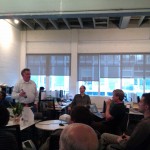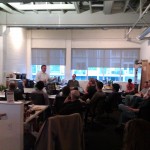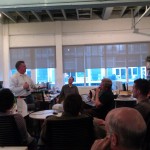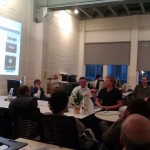Last week, I attended the very inspiring WebGL Developers Inaugural Meetup, organized by Damon Hernandez and Tony Parisi, two brilliant Silicon Valley innovators working on the development of Web3D technologies. The event took place at COLLAB, a collaborative workspace for architects, entrepreneurs and social innovators, where I also had the chance to visit the exciting group of socially-responsible architects called Architecture for Humanity. The event included presentations from Neil Trevett (Khronos Group), Henrik Bennetsen (Katalabs/OurBricks) and Kenneth Russell (software engineer in the San Francisco Bay Area).
For those who are not familiar with WebGL, it is a royalty-free hardware-accelerated 3D format that is built into the Web browser through HTML5 canvas and programmed in JavaScript. In everyday terms, it is interactive 3D content in your Web browser working natively (without need for downloading a plug-in or viewer).
WebGL Developers Group is a growing community of Web3D platform & content developers, as well as professionals working on open 3D format standards to comply with most online devices. Neil Trevett from Khronos Group, main sponsor of the event, presented the latest developments in WebGL technology and their other interconnected file standards such as OpenGL and OpenGL ES (3D visualization for mobile devices) and COLLADA (3D content transfer/storage protocol), which was developed by Remi Arnaud, another participant of the Meetup. Development of WebGL 1.0 was finalized in March 2011. It is compatible with desktop browsers Firefox 4.0 beta and Chrome 9, Mac OS nightly builds, Opera preview, and mobile browsers Firefox 4.0 Beta and Chrome OS.
So, why is WebGL important?
WebGL and other open standards for online 3D visualization are important for a number of reasons. As Neil Trevett explained very clearly in his presentation, the growing variety and performance of personal communication devices, increasing potential of ICTs for global collaboration among many professionals, and the need for better and more resourceful co-presence experiences shape the dream of Web3D. With the availability of OpenGL & OpenGL ES in more devices, increasing Java Script Performances, and development of HTML5 Canvas tech that supports 3D visualization, WebGL became a leading standard for artists, designers, architects and other content developers who want to share their 3D works online.
After Trevett, Henrik Bennetsen from OurBricks took the stage. Bennetsen was formerly a Stanford University researcher, working on development of the open-source VW platform Sirikata. Bennetsen’s Silicon Valley initiative Katalabs is known for its multiuser online space project called KataSpace, which uses WebGL technology to create a browser-based MUVE. KataSpace allows importing objects from OurBricks and working collaboratively on them. Bennetsen made a live demonstration of how 3D objects can be archived, visualized and embedded in browser-based virtual spaces using OurBricks and KataSpace, also how the Dutch game-designer community www.igad.nl integrated their online forum with their OurBricks collections.
One existing limitation of community-authored 3D VW platforms such as Second Life was the need to go through many tasks (download, register, create the avatar, learn the interface, etc.) before actually being able to manipulate 3D inworld objects. With WebGL-based virtual spaces, such as KataSpace and libraries like OurBricks, it is now possible to share 3D creations online via its URL, integrate them with social media or embed seamlessly to a web-site, or place them into a CVE, or a game that you want to design. Since WebGL is based on HTML, 3D content is not trapped in a rectangular window as a static visual component, so it is possible to create not just 3D content but also 3D interfaces. One great example is the Google Body Browser, which affords multiple layers of metadata attached to various 3D objects that surrounds the virtual body.
A remarkable event took place during the presentation of Kenneth Russell, who presented various inspirational experiments with WebGL and Google Chrome. Aleksandar Rodic, designer of the stunning WebGL application Chrysaora happened to be at the audience while Russell was introducing the project, which gave way to an interesting scene where Rodic joined him, introduced his design to the participants. This was one of those moments which made me glad to be in a rather casual Meetup with these Bay Area creatives, instead of just a highly-classified business meeting. With presentations and active discussions, the WebGL Developers Inaugural Meetup was an amazing evening, full of inspiration and enthusiasm; and a great deal of fresh collaborative vision in one room.
After last night’s visit to COLLAB, I was truly impressed and motivated by seeing what collaborative creativity of platform developers, designers and other multi-disciplinary actors can achieve with these new technologies. Right now, we are able to play the good old Quake in our browsers, or wonder around in KataSpace online. Tomorrow, maybe we’ll be wondering in a 3D version of social network sites, passing each other morph-shaped Tweets filled with audio-visuals through our mobile devices, or dancing with our Kinect friends at an online music-sim.
Here in Silicon Valley, technology is so charming that one could quite probably feel like everything is possible.







I know it’s a long post, and I may make it a little briefer soon. I was really impressed by the event, and I thought it deserved a fair review. So long Damon and Tony, and thanks for everything. I’ll keep posting from the WebGL Camp at Google this June (http://www.webglcamp.com)